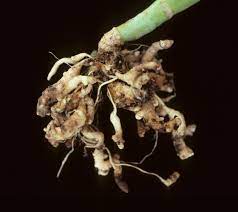|
Club root is a major problem that affects brassicas and unfortunately many plots on our site suffer from it. It is usually an inherited problem, possibly due to the cultivation techniques of previous tenants over the years. The bad news is that it is a slime mould that can survive as resting spores in the soil for up to 20 years. So if you have it, chances are you will never be rid of it because there are no chemicals to control it.
The 3 main contributors to club root are:
Brassicas are lime lovers and need a very limey soil with a pH of at least 7.5. So spread plenty of lime on your brassica patch. Chances are that you will not raise the pH in one growing season, but it can be achieved over several seasons. Digging in manure or garden compost will also help. Do rotate your crops every season. It helps to reduce the risk of spreading soil borne pests and diseases around the allotment site. Make sure your soil is well drained. You could do this by earthing up the soil to allow water to drain. You could also consider making a clean start by using raised beds filled with fresh, clean soil. Don’t accept gifts of brassicas that may already be infected with club root. Even a small amount of soil falling onto your plot from the roots can infect your soil. Club root can also be spread from soil on your boots, which is a good reason for not walking onto your neighbour’s soil and not allowing them to walk onto yours. Be courteous and stick to the paths. The last bit of good advice is to buy seeds that are club root resistant as these produce good brassicas even on infected soils. You may find that the roots will still be distorted but the plants are definitely good to eat. Good examples are: Sprouts – Crispus F1 Cauliflower – Clapton Cabbage – Kilaxy or Kilaton
0 Comments
Your comment will be posted after it is approved.
Leave a Reply. |
AuthorPlot holders cogitate and ruminate about allotment life. Archives
May 2022
Categories |
Copyright - Walton Road Allotment Society © 2023

